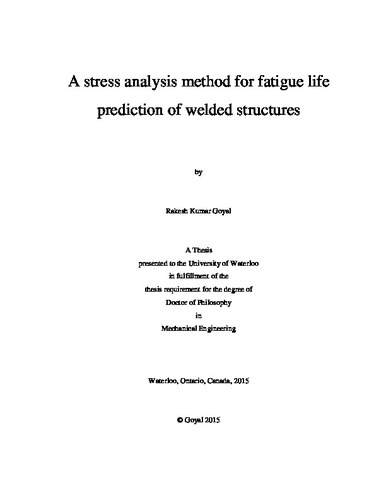| dc.contributor.author | Goyal, Rakesh Kumar | |
| dc.date.accessioned | 2015-04-07 13:40:37 (GMT) | |
| dc.date.available | 2015-04-07 13:40:37 (GMT) | |
| dc.date.issued | 2015-04-07 | |
| dc.date.submitted | 2015 | |
| dc.identifier.uri | http://hdl.handle.net/10012/9220 | |
| dc.description.abstract | In the case of structural weldments, the procedure for estimating fatigue life requires information concerning geometry of the object, loads and material. Detailed knowledge of stress fields in the critical regions of weldments is used to determine the fatigue life. The main theme of the research discussed in this thesis is to provide details of the methodology which has been developed to determine peak stress and associated non-linear through thickness stress distribution at the critical weld toe location by using only the geometry dependent stress concentration factors along with appropriate unique reference stress calculated in an efficient manner e.g. without modeling geometrical weld toe details. The peak stress at the weld toe can be subsequently used for estimating the fatigue crack initiation life. The non-linear through thickness stress distribution and the weight function method can be used for the determination of stress intensity factors and for the analysis of subsequent fatigue crack growth.
Accurate peak stress estimation requires 3D fine mesh finite element (FE) models, accounting for the micro-geometrical features, such as the weld toe angle and weld toe radius. Such models are computationally expensive and therefore impractical. On the other hand, stresses at sharp weld corners obtained from 3D coarse FE meshes are inaccurate and cannot be used directly for fatigue life estimations. A robust, sufficiently accurate, efficient and practical approach is proposed for fatigue life estimation of welded structures based on 3D coarse mesh FE models.
Another objective is to establish a methodology which is capable of accounting for the actual variability of stress concentration factors at welds, welding defects such as misalignment and incomplete penetration resulting from manufacturing processes. The proposed approach is capable of accounting for the effects from use of different material and effect of residual stresses from welding process. Residual stress information is obtained from a welding process simulation model, which has been validated against measured residual stress data.
The proposed methodology has been validated using numerical and experimental data by analyzing different weldments of varying geometrical and load configurations.
Further, the applicability of the stress field obtained from the proposed methodology is demonstrated by using it in a forward looking “Total Fatigue Life” concept based only on the fracture mechanics approach. | en |
| dc.language.iso | en | en |
| dc.publisher | University of Waterloo | en |
| dc.subject | Stress analysis | en |
| dc.subject | Fatigue Life Prediction | en |
| dc.subject | Welded Structures | en |
| dc.subject | 3D coarse mesh FE analysis | en |
| dc.subject | Total Fatigue Life | en |
| dc.subject | GR3 Methodology | en |
| dc.title | A stress analysis method for fatigue life prediction of welded structures | en |
| dc.type | Doctoral Thesis | en |
| dc.pending | false | |
| dc.subject.program | Mechanical Engineering | en |
| uws-etd.degree.department | Mechanical and Mechatronics Engineering | en |
| uws-etd.degree | Doctor of Philosophy | en |
| uws.typeOfResource | Text | en |
| uws.peerReviewStatus | Unreviewed | en |
| uws.scholarLevel | Graduate | en |

